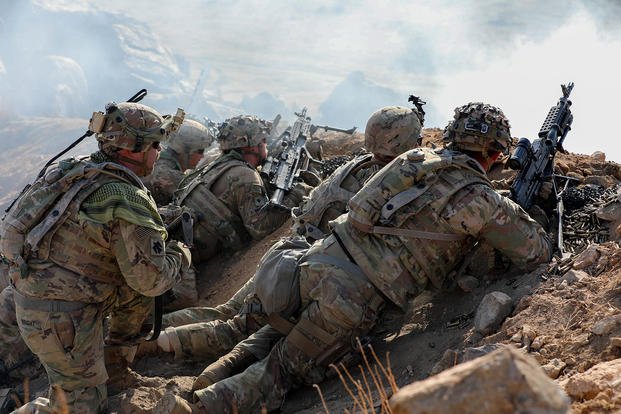While the Army recovers from decades of fighting guerrilla forces in the Middle East, leaders are setting their eyes on the wars of tomorrow. And despite rapid advances in cyberweapons, drones and artificial intelligence, they're stressing the next war will still feature bloody, close quarters combat
"All this technology is awesome, but it's going to come down to city fighting chucking grenades, and being able to do that over and over," Lt. Gen. Ted Martin told Military.com in an interview Thursday.
The U.S. has spent its last several campaigns mostly fighting enemies without much in the way of advanced technology. That wouldn't be true in a conflict with Russia or China, the two potential adversaries military planners continue to focus on in their preparations.
Read Next: With a Wink and a Nod, Japan Has an Aircraft Carrier Again
Martin, who commands the U.S. Army Combined Arms Center at Fort Leavenworth, said the next war won't just be "about pushing buttons," and that U.S. forces on the ground are going to have to quickly close in and destroy enemy forces who will come to battle equipped with artillery and aircraft.
Speed and mobility will be critical to evading enemy munitions, and getting close to an enemy quickly makes it harder for them to drop bombs due to the risk of hitting their own troops, or other collateral damage. Long gone will be the days of Afghanistan warfare, which often had troops in shoddy forward operating bases standing their ground against Taliban fighters with radios and basic rifles shooting down from ridgelines.
"We aren't going to be doing the type of fighting we were doing in 2003, when we had air superiority and dominated, and cyber wasn't as big of a player," Martin said. "What we are looking at is what weapons [adversaries] are investing in, what their doctrine says ... our competitors' ability to operate freely ... use satellites ... gives them surveillance on us and potentially subjects [American troops] to precision fires from long range. We need to rapidly close in and destroy."
After the peak of the Iraq and Afghanistan wars in the 2000s, the Pentagon has pursued a vast effort to modernize the force. A major culminating point of that effort was the establishment of the Space Force, given expectations the next major conflict will largely involve electronic warfare that could include attacks on electronic grids, financial institutions, elections and communications.
The Pentagon's so-called Third Offset Strategy, a plan to move military technology ahead by a generational leap, meant that the services focused on investing in emerging technologies. That meant establishing new offices focused on innovation and developing abilities in AI, hypersonic missiles and cyberwarfare.
A report to lawmakers from the nonpartisan Congressional Research Service last week highlighted that the U.S. is still more technologically advanced than China and Russia, but urged that competitive advantage could quickly shrink.
"Although the United States is the leader in developing many of these technologies, China and Russia -- key strategic competitors -- are making steady progress in developing advanced military technologies," the report said. "As they are integrated into foreign and domestic military forces and deployed, these technologies could hold significant implications for congressional considerations and the future of international security writ large."
This summer, China tested a hypersonic missile that has set off alarms among national security planners about a potentially waning U.S. military advantage. Gen. Mark A. Milley, the chairman of the Joint Chiefs of Staff, told Bloomberg on Wednesday the missile tests took the Pentagon by surprise, calling it "very close" to a "Sputnik moment," which spurred the space race during the Cold War.
But there's a dichotomy the Army is trying to balance. While new technology will likely be a key factor in the next war, Army leaders are urging that traditional ground combat will still be a major player.
"I hear the same conversations that the future of warfare will be some dude sitting down in his basement at his mom's house cyber hacking everyone, drinking a Monster [energy drink], and I push back on that hard," Brig.Gen. John Kline said during an Army webinar Thursday.
Part of preparing for chaotic ground warfare was the Army's move to extend basic training for some of the key combat jobs. Last year, training for tankers and cavalry scouts were extended to 22 weeks, from 15 and 17 weeks, respectively. That move, Martin said, will hopefully have better prepared privates, mostly with more trigger time behind weapons, showing up to their units that may be deploying overseas soon, or are already on the battlefield and unable to bring new soldiers up to speed.
The Army has also completely revamped how it tests physical fitness, with the Army Combat Fitness Test, a more comprehensive test with measurements of strength of speed. However, data obtained by Military.com in May showed that women are struggling to pass the test, which is set to become official next year.
The service is also eyeing methods to make it less burdensome for units to test for expert infantry, soldier and medic badges without making the tests themselves any less difficult. A side effect of more opportunities to earn those badges, leaders say, is more training on the fundamentals of combat skills.
-- Steve Beynon can be reached at Steve.Beynon@military.com. Follow him on Twitter @StevenBeynon.
Related: Our Next War in Afghanistan Is Already Looming. And It May Be Even Harder.












